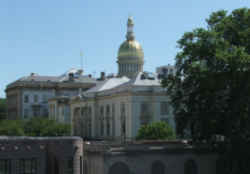

New Jersey History
Historic Facts & Overview of New Jersey History
Take a peek at New Jersey history. Discover an overview of New Jersey's rich history, heritage, historic events, and culture.
Italian Giovanni da Verrazano, in 1524, was the first European to explore the area we know today as New Jersey. One of the original 13 states (it joined the Union in 1787), it was named after the island of Jersey in the English Channel. New Jersey is referred to as the "Garden State" because of its fertile farmland. General George Washington won a key Revolutionary War battle at Trenton when he crossed the Delaware River from Pennsylvania and surprised the Hessian soldiers stationed there. Trenton is the state capital, and the flower is the purple violet. "Atlantic City, a resort town and former home to the Miss America pageant, attracts visitors from around the world."
Overview of New Jersey History and Heritage
Native Americans from the Delaware tribe lived in New Jersey when Europeans explorers first arrived. They built villages along the Delaware River, spending most of their time hunting and planting corn, beans, and other crops for food.
Giovanni da Verrazano was the first to explore the coast of New Jersey in 1524 for France. In 1609, Henry Hudson sailed up the Hudson River and claimed New Jersey and New York for the Dutch. Although Hudson was British, he worked for the Netherlands, so he claimed the land for the Dutch. It was called New Netherlands. Many other Dutch explorers followed. In 1614, the Dutch explorer Cornelius Mey (for whom Cape May, the southern tip of the state is named) sailed into the mouth of the Delaware River and built a tiny fort.
By 1630, Dutch settlement of New Jersey began along the western bank of the Hudson, with one on the Delaware at Fort Nassau; but these settlements were insignificant, and the history of the colony properly begins with the occupation of the territory by the English. Due to Indian attacks, the first permanent town, Bergen, wasn't established until 1660. Swedish fur traders began settling southern New Jersey in 1638, but were quickly forced out of the area by the Dutch.
New Jersey's early colonial history was involved with that of New York (New Netherlands), of which it was a part. In 1664 the Dutch lost New Netherlands when the British took control of the land and added it to their colonies. New Jersey was organized as an English colony under Gov. Philip Carteret. Many settlers arrived as land was sold inexpensively with the promise of political and religious freedom. In 1674, a Quaker colony arrived. In 1676 the colony was divided between Carteret (who was in charge of the east side)
and a company of English Quakers who had obtained the rights belonging to John, Lord Berkeley (who was in charge of the west side) into West and East Jersey. The land was officially named New Jersey after the Isle of Jersey in the English Channel. Carteret had been governor of the Isle of Jersey.
Two wholly separate governments were now set up, and they were as different as white from black. The stern New England Puritans had settled in East Jersey in sufficient numbers to give coloring to the laws, and in these laws (enacted by the first assembly before the division) we find enumerated thirteen crimes for which the penalty was death. In West Jersey the government was exceedingly mild. A code of laws with the name of Penn at the top gave all power to the people, and made no mention of capital punishment. This was the first example of Quaker legislation in America.
When James II became king of England he demanded the charters of the Jerseys on writes of quo warranto, leaving the ownership of the soil to the people, and united East and West Jersey to New York and New England under the government of Andros. At the fall of the king and the expulsion of Andros the Jerseys were left in a state of anarchy, and so it continued for more than ten years. The heirs of Carteret and the Quakers laid claim to the colony; and New York made a similar claim. After a long season of confusion it was decided to surrender the whole colony to the Crown, and in 1702 New Jersey became a royal province administered by the royal governor of New York initiated by Queen Anne. Finally, in 1738, New Jersey was separated from New York under its own royal governor, Lewis Morris.
During the 1760s, colonists began protesting high taxation and trade restrictions by England. In 1774, colonists from New Jersey burned a supply of tea from a British ship in what became known as the Greenwich Tea Burning. As the Revolutionary War began in 1775, New Jersey's loyalties were split. About one-third of the people living here supported the rebels, one-third supported England, and one-third remained neutral.
New Jersey was an important state during the Revolutionary War because of its location near the center of the thirteen colonies and between New York City and Philadelphia. Because of this, more battles were fought in New Jersey than in any other state. The Americans and British fought 100 battles, both large and small, here. Several important battles were fought in New Jersey, most importantly the battles of Trenton in 1776, which many consider to be the turning point of the Revolution. Immediately after winning Trenton, General George Washington won the battle of Princeton in 1777. Having lost two battles in a matter of hours, the British fled New Jersey for New York. Washington and his troops spent the rest of the winter in Morristown. Including the battle of Monmouth in 1778.
In 1776, New Jersey claimed independence from Great Britain. Two years later it adopted the Articles of Confederation. Finally, on December 18, 1787, New Jersey became the 3rd state of the Union as it ratified the US Constitution and the first state to sign the Bill of Rights. Trenton became the capital in 1790.
New Jersey became a massive industrial center during the early 1800s. Trenton, Camden, Passaic, Jersey City and Newark all became major manufacturing cities. Paterson became a textile center and later became known for producing trains and silk. Trenton produced clay products, iron, and steel. Industries increased as transportation expanded in South Jersey seashore areas by railroad and canal construction. Thousands came from Europe to work in the factories.
Although many sympathized with the South, New Jersey soldiers fought for the Union during the Civil War (1861-1865). During the Civil War, New Jersey provided 31 regiments (groups of soldiers), including cavalry (soldiers on horseback) and infantry (soldiers on foot). Over 25,000 New Jersey men fought for the Union, and New Jersey soldiers participated in almost every major Eastern battle.
After the war, several large corporations moved to New Jersey and cities like Trenton, Newark, Paterson, and Camden got bigger as immigrants from Europe came to work in them. The state then passed several laws that restricted business monopolies and provided workers' compensation and a public utilities commission.
At first, most immigrants came from Ireland and Germany. Later, people came from Italy and from countries throughout Eastern Europe. In 1910 half the state's population was born or had parents who were born outside the United States. As city populations grew, farm populations shrank.
With so many people working in factories, issues like child labor and protection for workers became important. The popularity of these reforms brought Woodrow Wilson to power as governor in 1910. He left office in 1913 to become President of the United States and is the only New Jersey governor to become president.
The state's economic expansion had a lot to do with the genius of its inventors. Thomas Edison is probably most famous. Among his thousands of inventions, including the light bulb, Edison helped develop the motion picture while working in New Jersey.
During World War I (1914-1918), thousands of soldiers left for Europe from the Hudson River. New Jersey factories made chemicals. Soldiers trained at Fort Dix. When the Great Depression hit in 1929, factories closed and many lost their jobs. The state rebounded during World War II (1939-1945) as New Jersey's electronics and chemical industries began large-scale operations.
After the war, people began moving back into the rural areas from the overcrowded cities. A number of transportation projects helped better connect New Jersey. The New Jersey Turnpike was completed in 1952 and the Garden State Parkway opened in 1955.
Poverty stricken and overcrowded cities led to riots during the 1960s. New Jersey's state government started rebuilding inner cities. Several bonds were issued to provide money for better government programs. The Pinelands National Reserve was established to protect plants, animals, land, and water.
In 1969, a state lottery was approved to raise money for education. Several schools were built or expanded. Gambling casinos were also allowed in 1977, to raise money for the disabled and the elderly.
The history of air travel has close ties to New Jersey. On May 3, 1919, the first passenger flight in American history was flown from New York to Atlantic City. Today, New Jersey is home to two international airports, Newark and Atlantic City. Newark Airport expanded its passenger and cargo services in 1963. In the 1980s, it became one of the world's busiest airports.
Recently New Jersey is attracting new industries. Several computer companies have created thousands of jobs. The state is still facing problems of pollution and high government costs.






